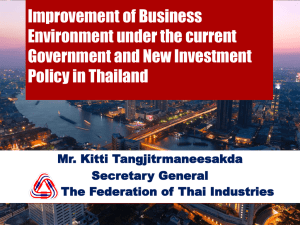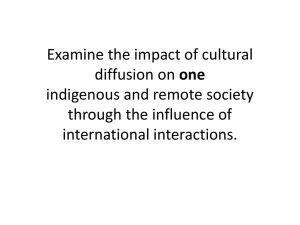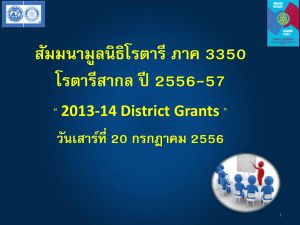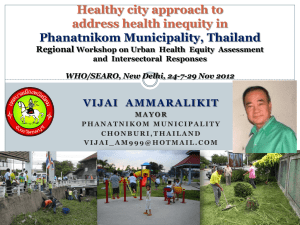Thailand
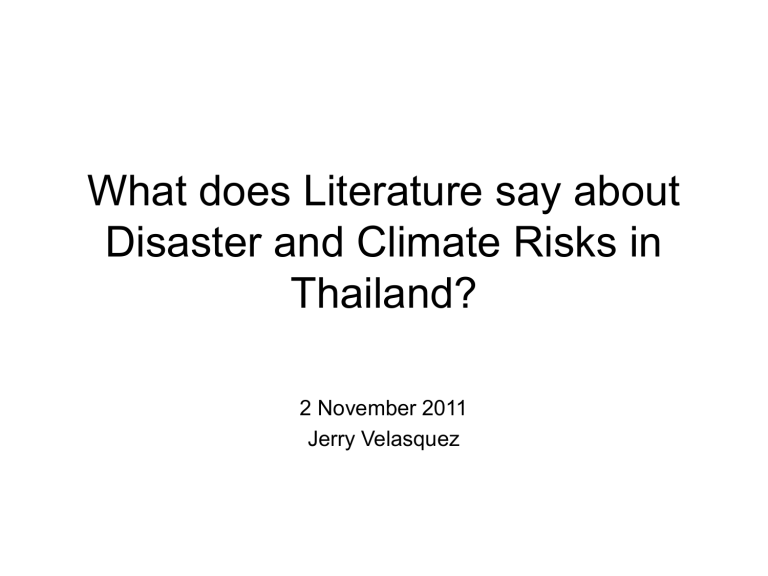
What does Literature say about
Disaster and Climate Risks in
Thailand?
2 November 2011
Jerry Velasquez
Climate Vulnerability Monitor
2010 – the State of the Climate
Crisis, DARA, 2010
Unless measures are taken, in the next 20 years will see major economic impacts in Thailand
• The largest developed economies in the world, including the US, Japan, and Germany are among the worst affected in absolute terms.
• But large developing economies such as Russia,
Brazil, and India, as well as Egypt in North Africa and Thailand and Indonesia in Southeast Asia also face significant burdens.
• Overall, the 10 countries bearing the largest burdens will collectively face 75% of economic losses in absolute terms.
Thailand is ranked 5 th among countries with the largest total climate-related economic losses by 2030
Predicted impact of climate change in Thailand is high, with economic stress acute by 2030
Climate Change Vulnerability
Mapping for Southeast Asia,
IDRC, 2009
SEA Climate hazard hotspots and dominant hazards
Climate hazard hotspots
Northwestern Vietnam
Eastern coastal areas of Vietnam
Mekong region of Vietnam
Bangkok and its surrounding area
Southern regions of Thailand
Philippines
Sabah state in Malaysia
Western and eastern area of Java Island,
Indonesia
Dominant hazards
Droughts
Cyclones, droughts
Sea level rise
Sea level rise, floods
Droughts, floods
Cyclones, landslides, floods, droughts
Droughts
Droughts, floods, landslides, sea level rise
Thailand multiple climate hazard index medium, as compared to its neighbors
Adaptive capacity to climate change of Thailand is high
Tropical cyclone frequency is low in Thailand (event per year from 1980-2003)
Flood frequency high in certain parts of Thailand (event per year from 1980-2001)
Drought frequency high in certain parts of Thailand (event per year from 1980-2000)
Landslide exposure in Thailand is low
Sea level rise - 5-m inundation zone is high in Bangkok area
Natural and Conflict related
Hazards in Asia Pacific, OCHA,
2009
• Thailand coping capacity is high
• Ten components of coping capacity:
– Hazard evaluation
– Consequence and vulnerability assessment
– Awareness-raising activities
– Sectoral regulations
– Structural defences
– Continuity planning
– Early warning
– Emergency response
– Insurance and disaster funds
– Reconstruction and rehabilitation planning
Coping capacity to disasters of Thailand high compared to its neighbors
Protecting Development Gains,
Asia Pacific Disasters Report
2010 ESCAP, UNISDR, 2010
In 30 years, Thailand had 101 disasters, 11,730 people killed, more than 53 million people affected and close to US$ 6 billion in losses due to disasters
Thailand had 54 million people affected by disasters over
30 years
1.3 percent of Thailand population (800,000 people) is exposed to floods. Thailand is ranked 6 th Asia Pacific wide in terms of exposure of population to floods
1.8 percent of Thailand’s GDP ($3 billion) is exposed to floods. Thailand is ranked 6 th Asia Pacific wide in terms of exposure of economy to floods
Synthesis Report on Ten ASEAN
Countries Disaster Risks
Assessment, UNISDR, World
Bank, 2010
Flood is the dominant hazard in
Thailand, with 1.5 events per year.
Floods cause the most economic damage to
Thailand, with an annual loss of US$ 164 million. The
5-year return period probabilistic loss is US$ 420 million, US$ 1.2 billion for 20-year return period, and
US$ 3.2 billion for a 200 year return period
The Economics of Climate
Change in Southeast Asia: A
Regional Review, Asian
Development Bank, 2009
Agriculture contributed to a 10.7% of the GDP in
Thailand and accounted for 42.3% of employment
Thailand has the highest ratio of annual freshwater withdrawal to total internal water resources (41.5%), which indicates the vulnerability of Thailand to changes in water resources
With climate change, the water balance has become an annual problem and, in recent years, an increasingly critical one. Changes in rainfall patterns and the frequency and intensity of rainfall have affected the quantity and quality of water resources from some watersheds (for example, Chaophraya Basin) down to rivers and estuaries
Rainfall in Thailand also decreased in the past 3 –5 decades compared to the first half of the last century. Rainfall intensity has also increased considerably.
In Thailand, extreme weather events include prolonged floods and droughts, landslides, and strong storm surges.
These extreme events have become more frequent and damaging.
Coastal Erosion
• Thailand’s 2,667-km shoreline is under serious threat from coastal erosion, which is occurring at the rate of 15 –25 meters per year in some places. Coastal erosion is a significant problem along the Gulf of Thailand from Trat province in the east to Narathiwat province in the south. A serious case has been reported in the small coastal village of Khun Samutchine, in Samut Prakan province south of
Bangkok. The people of the Khun Samutchine settlement previously enjoyed living in a diverse natural habitat with wetlands, mangrove swamps, and marshes that were home to a wide variety of flora and fauna. Due to coastal erosion and an advancing sea levels, most of these areas are now deforested, degraded, and devastated, and groundwater resources are already contaminated with seawater. Many families have been forced to abandon their coastal homes, as few people can afford to continue rebuilding houses washed away regularly by the sea.
Storm Surges
• Also in Thailand, storm surges have become stronger and more frequent.
Certain spots along the inner gulf (for example, areas along the upper south around Prachuab Khirikan province in southern Thailand) and the eastern tip of the south (in Narathiwas and Songkhla provinces) have been eroded by strong winds and the changing direction of seawater flows.
Its projected that Thailand will have less rain due to climate change
Climate Risks and Adaptation in Asian Coastal Megacities,
ADB, JICA, World Bank,
2010
Importance of BMR
• The Bangkok Metropolitan Region (BMR) is the economic center of Thailand. It is the headquarters for all of Thailand’s large commercial banks and financial institutions. The area to the east of Bangkok and Samut
Prakarn is also an important industrial zone.
• In 2006, the gross domestic product (GDP) of the
Bangkok Municipal Region was 3,352 billion baht, or 43 percent of the country’s GDP (7,830 billion baht).
• The annual average growth rate was 7.04 percent, and per capita GDP was 311,225 baht.
• The current official population of Bangkok is estimated to be about 10 million people (based on 2007 estimates) with an estimated growth rate of .64 percent between
2003 –07.
In 2007, 0.6 percent or 88,361 people in the BMR were poor. The poverty line for the Bangkok municipal region was 1,638 baht ($49) per person per month in 2007. The number of poor is an estimate and does not include unregistered people. Most of the poor live in condensed housing and are unregistered.
Main climate-related drivers of flooding
• Severe flooding in Bangkok is associated with heavier than normal rainfall occurring over several months during the monsoon period over the Chao Phraya watershed. The flooding can last several weeks to over a month.
• Intense short-duration rainfall over the city can cause localized flooding that normally lasts for less than 24 hours.
• Bangkok is not subject to direct hits from tropical typhoons or cyclones.
Non-climate drivers of flooding
• land subsidence
• Deforestation
• urbanization, and removal of natural attenuation
• basins (like wetlands) also contribute to flooding
Urban and land use planning in
Bangkok
• Modern urban land use planning in Bangkok started in the 1950s. Bangkok’s inner city contains the Grand
Palace, government offices, major universities and educational establishments, and 2-to-4-story row houses that are used as commercial and residential units. The inner city is a national historic conservation area where construction of high-rise buildings is prohibited.
• Urban growth in Bangkok, however, has progressed in a sometimes ad hoc manner and without a unified plan linking it to the surrounding areas.
• To remedy this problem, the government has developed a 50-year regional spatial plan (finished in 2007) that foresees growth of the surrounding areas. This plan also provides for significant environmental protection and wetland areas.
Land Subsidence
• Historic land subsidence in Bangkok has reduced from highs of 10 cm/year to 1 to 2 cm/year over the period of
1978 to 2007, and from 2002 to 2007 the rate had declined to 0.97 cm/year.
• Due to government efforts to control groundwater pumping, the average subsidence rate would continue to decline by 10 percent/year, assuming that current efforts to reduce groundwater extraction continue.
• Estimate of land subsidence by 2050 varied from 5 to 30 cm depending on the location.
Flood projections
• For instance, the current (2008) estimated annual inundated area in Bangkok and Samut Prakarn will increase to 734 km2 in 2050 under the A1FI scenario for a 1-in-30-year flood. That is a 30 percent increase.
• The inundation could be for varying depths and varying number of days, but about 7 percent of these provinces could remain under water for over a month
Maximum Water Depth for 1-in-30-year event, 2008 and 2050, A1FI
Floods will be more frequent - A flood event in 2008 that will inundate 625 km2 happens once in 50 years, but in 2050, the same flood will happen once every 15 years.
Floods will be more intense – A flood happening once every 15 years would increase from inundating about 450 km2 in 2008 to
625 km2 in 2050.
Impact of floods in the future
• By 2050, one in eight of the affected inhabitants will be from the condensed housing areas where most live below the poverty level.
• One-third of the total affected people may be subjected to more than a half meter inundation for at least one week.
Storm surge and sea level rise have relatively small role in contributing to flooding in Bangkok
• There is a linear relationship between future precipitation and flood volume in the Chao Phraya River. However, it found that flood peak discharge in the Chao Phraya
River will increase by a larger percentage than precipitation, due to unequal travel times of floods from upstream catchments.
• Further, while storm surges and sea level rise are important, they will have less effect on flooding in
Bangkok.
• While storm surges do occur in the Gulf of Thailand and contribute to flooding the BMR area, it was estimated that the flood-prone area in Bangkok and Samut Prakarn will increase by about 2 percent due to a storm surge striking the western coast of the Gulf of Thailand
World Risk Report, UNU,
2011
• Thailand has moderate risk rating, and is ranked
85 th in the world
• Thailand has low susceptibility and high adaptive capacity to disasters
Global Assessment Report on DRR, UNISDR, 2011
2010 GDP distribution in Thailand
Historical flood events 1970-2010
Flood risk for Thailand
Flood as observed
UNOSAT
Global Flood Model
UNEP/GRID-Geneva
Difference observed versus modelled
Heavy rainfall over the
Indochina Peninsula for June to September 2011, JMA,
2011
Four-month total precipitation from June to September 2011 was 120%
– 180% of the normal.
Four-month total precipitation amounts to 921mm (134% of the normal) at Chiang
Mai in northern Thailand and 1251mm (140%) at Bangkok (the capital of Thailand),
It is unusual that heavier-than-normal rainfall continued through the rainy season over the entire area of the basins
The heavier-than-normal rainfall over the basin of the Chao Phraya River continued in the first half of October 2011.

